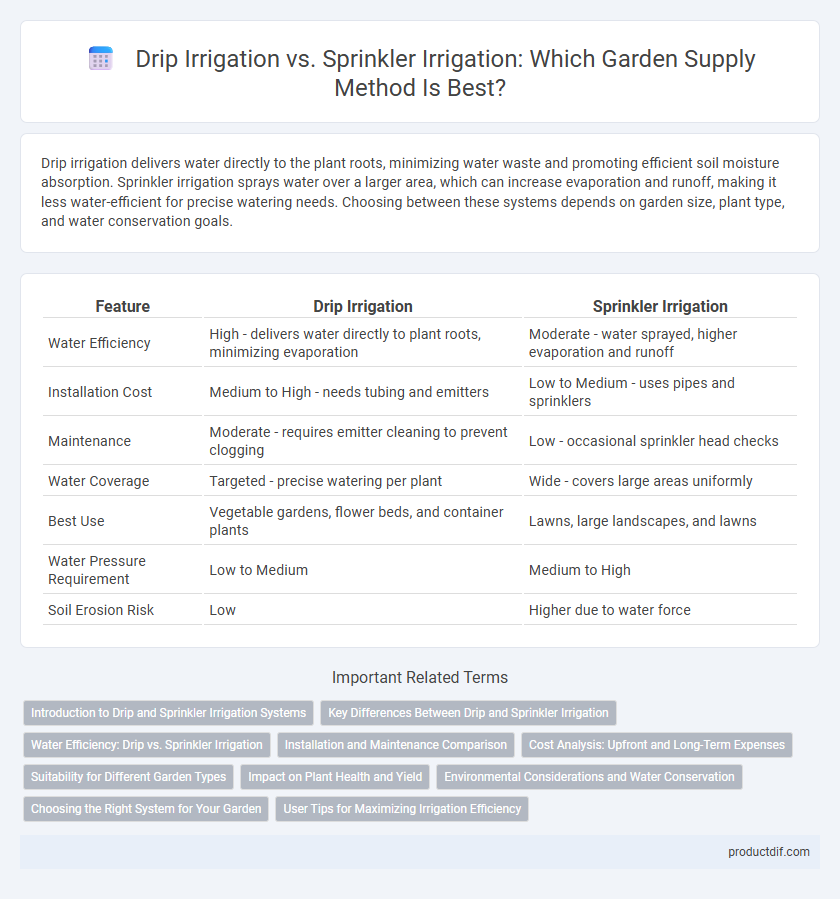Drip irrigation delivers water directly to the plant roots, minimizing water waste and promoting efficient soil moisture absorption. Sprinkler irrigation sprays water over a larger area, which can increase evaporation and runoff, making it less water-efficient for precise watering needs. Choosing between these systems depends on garden size, plant type, and water conservation goals.
Table of Comparison
| Feature | Drip Irrigation | Sprinkler Irrigation |
|---|---|---|
| Water Efficiency | High - delivers water directly to plant roots, minimizing evaporation | Moderate - water sprayed, higher evaporation and runoff |
| Installation Cost | Medium to High - needs tubing and emitters | Low to Medium - uses pipes and sprinklers |
| Maintenance | Moderate - requires emitter cleaning to prevent clogging | Low - occasional sprinkler head checks |
| Water Coverage | Targeted - precise watering per plant | Wide - covers large areas uniformly |
| Best Use | Vegetable gardens, flower beds, and container plants | Lawns, large landscapes, and lawns |
| Water Pressure Requirement | Low to Medium | Medium to High |
| Soil Erosion Risk | Low | Higher due to water force |
Introduction to Drip and Sprinkler Irrigation Systems
Drip irrigation systems deliver water directly to the plant root zone through a network of valves, pipes, tubing, and emitters, ensuring efficient water use and minimizing evaporation. Sprinkler irrigation systems distribute water through overhead sprays, simulating rainfall and covering larger areas quickly, but with higher water loss due to wind drift and evaporation. Both systems offer distinct advantages depending on crop type, soil conditions, and water availability.
Key Differences Between Drip and Sprinkler Irrigation
Drip irrigation delivers water directly to the root zone of plants, minimizing evaporation and runoff, making it highly efficient for water conservation in garden supply. Sprinkler irrigation distributes water over a larger area from above, simulating rainfall but often resulting in higher water loss due to evaporation and wind drift. While drip systems target individual plants with precise water application, sprinkler systems are better suited for uniformly irrigating lawns and large garden beds.
Water Efficiency: Drip vs. Sprinkler Irrigation
Drip irrigation delivers water directly to plant roots through a network of tubes and emitters, minimizing evaporation and runoff, making it up to 70-90% efficient in water use. Sprinkler irrigation sprays water over a wide area, often resulting in higher evaporation and wind drift losses, with typical water efficiency around 65-75%. For garden supply and water conservation, drip systems provide superior water efficiency, reducing overall consumption while promoting healthier plant growth.
Installation and Maintenance Comparison
Drip irrigation systems require precise installation with emitters placed near plant roots, minimizing water waste and soil erosion, while sprinkler irrigation involves installing overhead spray heads covering larger areas but needing careful alignment to avoid runoff. Maintenance for drip irrigation includes regular emitter clogging checks and occasional tubing replacement, whereas sprinkler systems demand frequent head cleaning, nozzle adjustments, and seasonal winterization to prevent freeze damage. Overall, drip irrigation offers lower water use maintenance benefits, but sprinkler systems provide easier coverage adjustments and repair access for extensive garden areas.
Cost Analysis: Upfront and Long-Term Expenses
Drip irrigation systems typically have higher upfront costs due to emitters, tubing, and installation, but they offer significant water savings and reduced plant disease, lowering long-term expenses. Sprinkler irrigation requires less initial investment but can lead to higher water usage and maintenance costs over time. Considering local water rates and garden size is crucial for an accurate cost analysis between these irrigation methods.
Suitability for Different Garden Types
Drip irrigation suits small gardens, raised beds, and areas with water-sensitive plants by delivering water directly to the root zone, minimizing evaporation and runoff. Sprinkler irrigation is ideal for large lawns, flower beds, and landscapes requiring uniform coverage over wide areas. Gardens with varied plant types benefit from combining both systems to optimize water efficiency and plant health.
Impact on Plant Health and Yield
Drip irrigation delivers water directly to the root zone, minimizing water wastage and reducing the risk of fungal diseases, thereby promoting healthier plant growth and higher yield. Sprinkler irrigation distributes water over a wider area but can increase leaf wetness, leading to greater susceptibility to pests and diseases, potentially lowering overall crop productivity. Efficient water application through drip systems enhances nutrient absorption and supports consistent moisture levels, ultimately improving plant vitality and maximizing harvest output.
Environmental Considerations and Water Conservation
Drip irrigation delivers water directly to plant roots, minimizing evaporation and runoff, which significantly conserves water and reduces soil erosion. Sprinkler irrigation covers larger areas but often results in higher water loss due to evaporation and wind drift, making it less efficient in water conservation. Choosing drip systems supports sustainable gardening by optimizing water use and reducing environmental impact.
Choosing the Right System for Your Garden
Drip irrigation delivers water directly to plant roots, minimizing water waste and promoting healthy growth, making it ideal for gardens with diverse plant types or limited water supply. Sprinkler irrigation covers larger areas quickly, suitable for lawns or gardens requiring uniform water distribution but may lead to evaporation and runoff. Selecting the right irrigation system depends on garden size, plant species, soil type, and water efficiency goals to maximize growth and conserve resources.
User Tips for Maximizing Irrigation Efficiency
Drip irrigation conserves water by delivering it directly to plant roots, reducing runoff and evaporation, making it ideal for gardens with diverse plant types. Sprinkler irrigation covers larger areas quickly but requires precise timing to minimize water waste caused by wind or overspray. Users should regularly check for leaks, adjust scheduling based on weather, and consider combining both systems to optimize water use and promote healthy plant growth.
Drip irrigation vs Sprinkler irrigation Infographic

 productdif.com
productdif.com